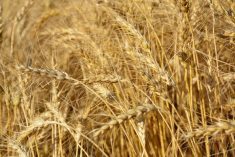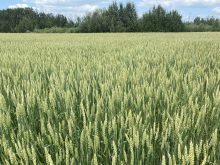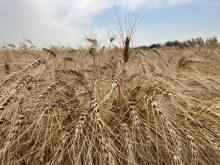The Alberta government is removing fusarium graminearum from its pest regulation, a move industry says will allow for better management of the disease.
The government said in a news release today that regulating the disease has failed to stop it, arguing the changes allow for the modernization of management practices.
It said rates of fusarium have increased over the past 20 years and the provincial management plan doesn’t account for advances in seed treatment options, which can bring detections close to zero.
“This long-overdue change creates new opportunities for our farmers by levelling the playing field,” agriculture minister Devin Dreeshen said in a news release.
Read Also

Farming Smarter receives financial boost from Alberta government for potato research
Farming Smarter near Lethbridge got a boost to its research equipment, thanks to the Alberta government’s increase in funding for research associations.
“Modernizing these rules means that Alberta farmers will benefit from current research advances.”
Farm group representatives who are part of the fusarium head blight working group welcomed the changes.
It said in a news release today that the removal of fusarium from the Pest Nuisance Control Regulation of the Agricultural Pests Act will allow for sustainable mitigation.
“This news has been a long time coming,” Todd Hames, chair of the Alberta Wheat Commission, said in the news release.
“Fusarium head blight is well-established in Alberta and since it’s spread through air-borne spores, we know that zero tolerance policies are not effective,” he said.
Farm groups have long advocated for fusarium’s removal from the regulation. They have instead wanted a province-wide approach that promotes the extension and education of best management practices.
Fusarium is a fungal disease of cereal crops that affects grain development and quality.
Tom Coppock, president of Alberta Seed Processors, said the organization has been asking for reform for years.
He said the legislative amendment will allow farmers to focus on risk factors to better manage the disease.
“Using high quality seed that has been tested by an accredited laboratory is still one of many important fusarium head blight mitigation tools that farmers will continue to utilize,” he said.
“Alberta Seed Processors will continue to work with the crop value chain in fusarium head blight mitigation efforts. Let’s manage it.”
The regulation has prevented producers from acquiring, selling, distributing or using any seed or plant material that contains the pest.
Some seed growers have previously said that the regulation forces producers with small amounts of detectable fusarium to dump their seed.
“This will result in more investment and innovation through seed research and other initiatives in Alberta.” #ableg #AbAg https://t.co/6SITkApkAk pic.twitter.com/Duz7XgLzbQ
— Devin Dreeshen (@DevinDVote) June 3, 2020
As well, farmers have said they’ve been required to buy seed from outside the province because of local seed shortages.
Georges Chaussé, president of the Canadian Seed Trade Association, said fusarium’s removal from the regulation will encourage research, investment and innovation in managing the disease. It will allow Alberta farmers to stay competitive, he added.
The Alberta wheat and barley commissions, in collaboration with the working group, are developing a website called Let’s Manage It!
It said the website will be a one-stop resource for farmers looking to mitigate fusarium, providing them with practices they can implement as needed. The website will be accessible at www.manageFHB.ca.
Contact jeremy.simes@producer.com


















